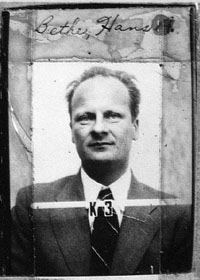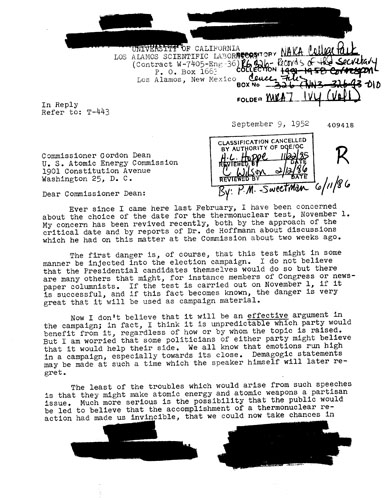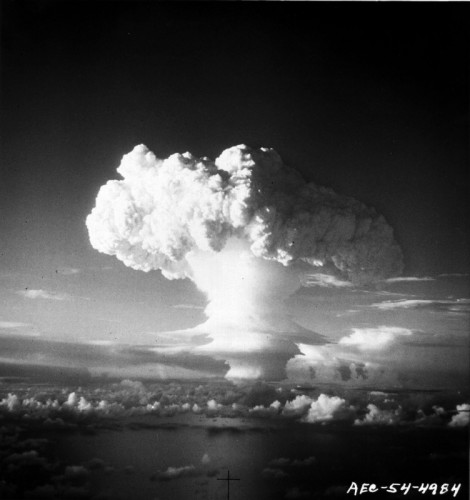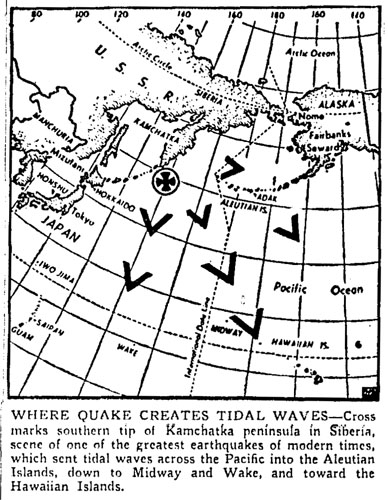 To say that Hans Bethe was a fascinating character would be something of colossal understatement. His stance on the hydrogen bomb is one of the most enigmatic: in early 1950, he strongly lobbied against Truman’s “crash” program. Two weeks after Truman’s announcement on the H-bomb (and the unveiling of Klaus Fuchs, which was almost simultaneous), Bethe wrote to the Chairman of the Atomic Energy Commission, Gordon Dean, explaining that:
To say that Hans Bethe was a fascinating character would be something of colossal understatement. His stance on the hydrogen bomb is one of the most enigmatic: in early 1950, he strongly lobbied against Truman’s “crash” program. Two weeks after Truman’s announcement on the H-bomb (and the unveiling of Klaus Fuchs, which was almost simultaneous), Bethe wrote to the Chairman of the Atomic Energy Commission, Gordon Dean, explaining that:
The announcement of the President has not changed my feelings in this matter. I still believe that it is morally wrong and unwise for our National security to develop this weapon. … The main point is that I can not in good conscience work on this weapon. 1
But, for complicated reasons that Sam Schweber has discussed in his classic book, In the Shadow of the Bomb: Oppenheimer, Bethe, and the Moral Responsibility of the Scientist (Princeton University Press, 2000), Bethe eventually changed his position and played a key role in the development of the Super bomb. Why? Initially he hoped that he could prove that it couldn’t be done — which was certainly the case with Teller’s initial “Classical Super” plan that so much effort was expended on. But it was not long until a better way was found. (Sam’s newest book, Nuclear Forces: The Making of the Physicist Hans Bethe, covers Bethe’s earlier years. I’ve no doubt it’s a good read.)
On Monday, I indicated that I really think that US could have not ordered an H-bomb crash program in1950 and come out pretty well on top of things even if the Soviets had roared ahead with their own program. Last Wednesday, I talked about how the test of the first H-bomb in November 1952, Ivy MIKE, leaked out almost immediately, despite attempts to keep it secret.
For today, I want to share a document in between these two dates: a letter by Hans Bethe, written to Gordon Dean, from September 1952. Bethe’s subject: why the US should postpone the testing of MIKE. 2
Why would Bethe want the first H-bomb not to be tested? Interestingly, it wasn’t because of any argument about the arms race — perhaps not a surprise, given that by this time, Bethe was firmly of the position that the H-bomb was “inevitable” since it did appear to be workable.
No, it was about Politics with a capital “P.” The Operation Ivy test schedule was for November 1 — just three days before voting day in the 1952 Presidential election. In Bethe’s view, this was too close:
Ever since I came here [Los Alamos] last February, I have been concerned about the choice of the date for the thermonuclear test, November 1. …
The first danger is, of course, that this test might in some manner be injected into the election campaign. I do not believe that the Presidential candidates themselves would do so but there are many others that might, for instance members of Congress or newspaper columnists. If the test is carried out on November 1, if it is successful, and if this fact becomes known, the danger is very great that it will be used as campaign material.
Now I don’t believe that it will be an effective argument in the campaign; in fact, I think it is unpredictable which party would benefit from it, regardless of how or by whom the topic is raised. But I am worried that some politicians of either party might believe that it would help their side. We all know that emotions run high in a campaign, especially towards its close. Demagogic statements may be made at such a time which the speaker himself will later regret.
But this short term problem was only part of the problem:
The least of the troubles which would arise from such speeches is that they might make atomic energy and atomic weapons a partisan issue. Much more serious is the possibility that the public would be led to believe that the accomplishment of a thermonuclear reaction had made us invincible, that we could now take chances in foreign policy and perhaps even risk a major war. It would take a long time to correct this impression, and in trying to do so, we would be unable to use some of the most potent arguments because they are classified. A few words said in the heat of battle can thus do permanent damage to the public attitude on this matter.
So this is an interesting connection to make: the use of the H-bomb as a talking point in the heat of an election could lead to a complete misunderstanding of the H-bomb itself. Note that it’s not an argument for secrecy: it’s an argument against testing the first H-bomb in the middle of an election.
But “the most important reaction” in Bethe’s view would be that of the international community:
If our test becomes publicly known, and I think the chances for this are enhanced if it is held during the election campaign, it will undoubtedly give food to the Communist propaganda machine. This propaganda is apt to be quite effective because I believe that the knowledge of a successful thermonuclear test will create fear in the countries of Western Europe rather than confidence. A few belligerent or merely incautious remarks by some people in this country will play into the hands of Communist propaganda by convincing many otherwise friendly people abroad that this is an important step towards our starting a war. “Neutralism” will be strengthened, to an extent that it may influence the policy of European governments and become very hard to deal with. There is of course no guarantee that inappropriate remarks will not be made outside of a campaign, but the danger is much greater during it.
The connection between this and the domestic election, again, is that the election season would make the chances of a leak — and sensationalism — much higher than any other point in time. (Bethe also notes that this isn’t just about the Presidential candidates — there were plenty of Congressmen up for re-election as well.)
Bethe also thought that a leak was going to be likely whenever you had the test, because, frankly, it’s hard to keep something as big as an H-bomb a secret.
If there is no disclosure, the test may still become public knowledge because of large fall-outs, visual observations from Kwajalein, or possibly observations of shock or seismic phenomena. Whichever may be the method of revelation, the evidence of a test with enormous yield combined with a lot of previous discussion in the columns of newspapers will almost undoubtedly lead the public to the right conclusion.
At the very least, Bethe thought it should be postponed until November 5, the day after the election, if not longer. (Bethe’s ideal date was November 15.)
The rest of the letter concerns whether the Presidential candidates should be informed about the prospective test. Bethe figures this should be easy; both Eisenhower and Adlai Stevenson were trustworthy figures. Bethe thought Oppenheimer would be a great guy to give them the head’s up.
Bethe could see only benefit to delaying it. Changing the date of the shot might increase the chances slightly of bad weather, but not much. “The effect of a postponement by two weeks or a month on the general thermonuclear program of the Laboratory would be almost unnoticeable.”
As we know, this suggestion went unheeded… and the news of the test did leak almost immediately to the press.
But… surprisingly, none of the leaks hit the newspapers until November 7, 1952, when a story by Elton C. Fay went out on the AP wire. 3 (Eye-witness stories began running on November 8. 4)
It’s hard not to see this as anything other than restraint on behalf of those at the press who had known about the success of Ivy MIKE within hours of the test. And here Bethe thought they couldn’t keep a secret! Well, they could keep it for almost a week, anyway.
Curiously, an event did happen in between that time that engendered H-bomb speculation — and it didn’t have anything to do with the election, or even the H-bomb test itself. On November 4, 1952, a massive 9.0 earthquake occurred off of Kamchatka, the Russian peninsula north of Japan. The result was a tsunami for Japan and 13 foot waves in Hawaii. It was the third-largest earthquake of the 20th century, according to USGS.
At least one major newspaper’s story about the quake was devoted to speculation as to whether it was a hydrogen bomb or not:
A senior Canadian Government scientist said it is not impossible that the earthquake was in reality the explosion of a hydrogen bomb. “It’s one possibility,” he said, but it’s pretty well down the list. It’s theoretically possible, but pretty hard to believe. I’m assuming it’s an earthquake until something else is proved.” 5
Of course, in that instance, it would be far more likely to be a Soviet bomb than an American one (unless the Americans were getting exceedingly bold), but in any case, it’s an interesting coincidence — one that, with a little prodding, could have revealed the fact that an H-bomb had in fact been tested in the Pacific only a few days before.
- Hans Bethe to Gordon Dean (14 February 1950), copy in the Nuclear Testing Archive, Las Vegas, NV, document NV0125241.[↩]
- Citation: Hans Bethe to Gordon Dean (9 September 1952), copy in the Nuclear Testing Archive, Las Vegas, NV, document NV0409418.[↩]
- The Fay story appeared under different headlines — and sometimes without a by-line — in many newspapers, e.g. “H-Bomb Test Explosion in Pacifc Hinted,” Los Angeles Times (7 November 1952), 1.[↩]
- The anonymous “eye-witness account” is pretty wonderful, in and of itself. From a version of the story carried in the Washington Post:
The blast, the letter said, was viewed through dark glasses and “appeared a huge orange ball, which grew larger and brighter until it appeared as if no dark glasses where there at all.”
Intense heat was felt almost immediately, the writer continued, adding:
“The ball of fire started to rise and slowly lose its intensity. We took off our glasses and saw water vapor suddenly form around the column. Then it rushed into the base of the column and up, clearing the air so that you could see countless tons of water rushing skyward.
“The column went up and up and finally mushroomed. About three minutes later the report, like a nearby cannon shot, hit us and was followed by several seconds of dull rumbling . . .
“All we could do was stand there and gasp in amazement and awe at the enormous size and force released before us. Typical comment from old timers: ‘Holy cow! That sure makes the A-bomb a runt.’
“And so I saw the first H-bomb explode.”
“‘First H-bomb Blast’ Described in Letter,” Washington Post (9 November 1952), M7.[↩]
- “13-Foot Hawaii Waves Follow Siberia Quake,” Daily Boston Globe (5 November 1952), 1.[↩]






In the first paragraph, I suspect you meant to write that Bethe wrote to Dean, not Fuchs.
D’oh! Fuchs on the brain. I’ve fixed it.
[…] being burnt. Hans Bethe, on the other hand, did have some moments of considerable ethical wavering (his stance on the H-bomb being the most well-known), but generally speaking stood up for the right side of things and was […]
Hi, this is certainly a sideline issue but I was, so-to-speak right in the middle of the Ivy Mike Project and have a rather personal question. Is there any information available on where the code name “Mike” came from? My father Eugene Beall was a machinist working on the Mike Shot “Sausage” and other related structures at Los Alamos. I was born during the project period on 12 March 1952. Was I the “Little Mike” and the device “Big Mike”? Seems plausible, guys around the shop talking about Gene’s new son – hey, let’s call it the Mike shot.
Hi Michael: My understanding (which is just based on what other people have written) is the “Mike” was for “Megaton” (whereas “King” was a kiloton-range shot), but I really don’t know. Separately, I’ve heard that “Sausage” was a nickname for the staged device coined by John Wheeler. At the end of this post I quote an interview with Ted Taylor where he explains the “Sausage” term — that it was about the stages being “linked” together.
I know someone else I can ask, though — a scientist who worked on Mike — so let me see what he has to say.
Thanks for the quick reply! I hope it wasn’t me but the notion sort of haunts me, I guess. Are there any public sources of info on the staff back then? These secretive times left a lot of children with questions about the lives of their secretive dads.